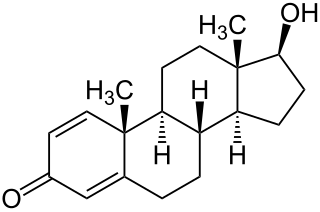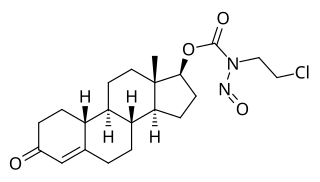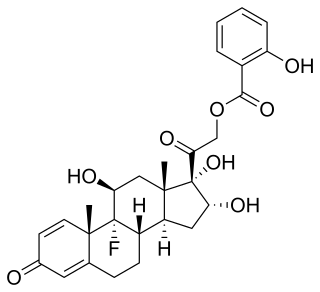
Boldenone, is a naturally occurring anabolic–androgenic steroid (AAS) and the 1(2)-dehydrogenated analogue of testosterone. Boldenone itself has never been marketed; as a pharmaceutical drug, it is used as boldenone undecylenate, the undecylenate ester.

Fluorometholone, also known as 6α-methyl-9α-fluoro-11β,17α-dihydroxypregna-1,4-diene-3,20-dione, is a synthetic glucocorticoid which is used in the treatment of inflammatory eye diseases. The C17α acetate ester, fluorometholone acetate, is also a glucocorticoid and is used for similar indications.

Metenolone enanthate, or methenolone enanthate, sold under the brand names Primobolan Depot and Nibal Injection, is an androgen and anabolic steroid (AAS) medication which is used mainly in the treatment of anemia due to bone marrow failure. It is given by injection into muscle. Although it was widely used in the past, the drug has mostly been discontinued and hence is now mostly only available on the black market. A related drug, metenolone acetate, is taken by mouth.

Etafedrine, sold under the brand name Nethaprin among others and also known as N-ethylephedrine, is a sympathomimetic agent used as a bronchodilator to treat asthma. It was previously commercially available as both the free base and as the hydrochloride salt from Sanofi-Aventis but is now no longer marketed.

Stenbolone is an anabolic–androgenic steroid (AAS) of the dihydrotestosterone (DHT) group which was never marketed. A C17β ester prodrug of stenbolone, stenbolone acetate, is used as an AAS for depot intramuscular injection under the brand names Anatrofin and Stenobolone.

Norclostebol is a synthetic androgen and anabolic steroid (AAS) that was derived from nandrolone. It was described in the literature in 1957. Norclostebol is also used as an ester, norclostebol acetate.

Chloral betaine, also known as cloral betaine (INN), is a sedative-hypnotic drug. It was introduced by Mead Johnson in the United States in 1963. It is a betaine complex of trimethylglycine with chloral hydrate, which acts as an extended-acting formulation of chloral hydrate which is then metabolized into trichloroethanol, which is responsible for most or all of its effects.

Testosterone phenylpropionate, or testosterone phenpropionate, also known as testosterone hydrocinnamate, is a synthetic anabolic-androgenic steroid (AAS) and an androgen ester – specifically, the C17β phenylpropionate ester of testosterone – which was formerly marketed in Romania. It was first synthesized in 1951 and was first described in the literature by 1953. The medication was an ingredient of several isolated AAS commercial products, but was never widely used. Testosterone phenylpropionate was also notably a component of Sustanon and Omnadren, as well as of Estandron Prolongatum, Lynandron Prolongatum, and Mixogen. TPP was previously available in Great Britain.

Methylephedrine, sold under the brand name Metheph among others, is a sympathomimetic medication described as an antiasthmatic agent and used to treat coughing and nasal congestion. It is reported to be used in various over-the-counter cough and cold preparations throughout the world, including Japan.

Doisynoestrol, also known as fenocycline, as well as cis-bisdehydrodoisynolic acid 7-methyl ether, is a synthetic nonsteroidal estrogen of the doisynolic acid group that is no longer marketed. It is a methyl ether of bisdehydrodoisynolic acid. Doisynoestrol was described in the literature in 1945. It has about 0.02% of the relative binding affinity of estradiol for the estrogen receptor.

LS-1727 is a synthetic, injected anabolic–androgenic steroid (AAS) and a nitrosocarbamate ester of nandrolone (19-nortestosterone) which was developed as a cytostatic antineoplastic agent but was never marketed.

Norclostebol acetate, or norchlorotestosterone acetate (NClTA), also known as 4-chloro-19-nortestosterone 17β-acetate or as 4-chloroestr-4-en-17β-ol-3-one, is a synthetic, injectable anabolic-androgenic steroid (AAS) and derivative of 19-nortestosterone (nandrolone). It is an androgen ester – specifically, the C17β acetate ester of norclostebol (4-chloro-19-nortestosterone).

Metenolone acetate, or methenolone acetate, sold under the brand names Primobolan and Nibal, is an androgen and anabolic steroid (AAS) medication which is used mainly in the treatment of anemia due to bone marrow failure. It is taken by mouth. Although it was widely used in the past, the drug has mostly been discontinued and hence is now mostly no longer available. A related drug, metenolone enanthate, is given by injection into muscle.

Clostebol acetate is a synthetic, injected anabolic-androgenic steroid (AAS) and a derivative of testosterone that is marketed in Germany and Italy. It is an androgen ester – specifically, the C17β acetate ester of clostebol (4-chlorotestosterone) – and acts as a prodrug of clostebol in the body. Clostebol acetate is administered via intramuscular injection.

Androstenediol dipropionate, or 5-androstenediol 3β,17β-dipropionate, also known as androst-5-ene-3β,17β-diol 3β,17β-dipropionate, is a synthetic anabolic–androgenic steroid and an androgen ester – specifically, the dipropionate diester of 5-androstenediol (androst-5-ene-3β,17β-diol) – which has been marketed in Europe, including in Spain, Italy, and Austria.

Androstenediol 17β-acetate, or 5-androstenediol 17β-acetate, also known as androst-5-ene-3β,17β-diol 17β-acetate, is a synthetic anabolic-androgenic steroid and an androgen ester – specifically, the C17β acetate ester of 5-androstenediol (androst-5-ene-3β,17β-diol) – which was never marketed.

Dacuronium bromide is an aminosteroid neuromuscular blocking agent which was never marketed. It acts as a competitive antagonist of the nicotinic acetylcholine receptor (nAChR).

Cortobenzolone, also known as betamethasone salicylate, is a synthetic glucocorticoid corticosteroid and corticosteroid ester which is marketed in Spain.

Bufenadrine, also known as 2-tert-butyldiphenhydramine, is a drug described as an antiemetic, antihistamine, anticholinergic, and antiparkinsonian agent which was never marketed. It is the 2-tert-butyl analogue of diphenhydramine. The drug was found to produce stereoselective hepatotoxicity in animals and this led to the discontinuation of its development. Bufenadrine was first described in the literature by 1967. Its INNTooltip International Nonproprietary Name suffix "-drine" is generally for sympathomimetics but bufenadrine itself is not actually a sympathomimetic or related agent.



















